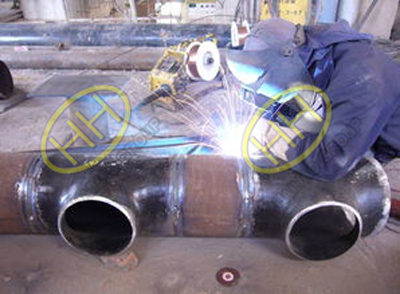Mastering the art of welding medium carbon steel: Techniques for stronger, crack-free joints
As an expert in pipeline systems, Haihao Group frequently handles prefabrication orders, many of which involve welding. Medium carbon steel welding presents specific challenges due to its higher carbon content compared to low carbon steel.
Weldability of Medium Carbon Steel
Medium carbon steel has moderate weldability. When the carbon content is close to the lower limit (0.25%), its weldability remains good. However, as the carbon content increases, the steel’s hardenability also rises, making the heat-affected zone (HAZ) more prone to forming low-plasticity martensite. If the welded structure has high rigidity or improper welding materials and parameters are used, cold cracking can occur.
During multi-pass welding, the first weld layer tends to absorb a higher proportion of base metal, leading to increased carbon, sulfur, and phosphorus content, which raises the risk of hot cracking. Additionally, higher carbon content increases the sensitivity to porosity.
Welding Process of Medium Carbon Steel
1.Preheating and Interpass Temperature Control
Preheating is an effective method to prevent cracking in medium carbon steel welding and repair. It reduces the cooling rate of the weld metal and HAZ, thereby suppressing martensite formation. The preheat temperature depends on factors such as carbon content, base metal thickness, structural rigidity, electrode type, and welding method. Ideally, the entire workpiece should be preheated. If only localized preheating is possible, the heated area should extend 150–200mm on both sides of the weld joint. For multi-pass welding, the interpass temperature should generally not be lower than the preheat temperature.
2.Shallow Penetration Welding
To minimize the proportion of base metal mixing into the weld, U-shaped or V-shaped grooves can be used for joint preparation. When repairing casting defects, the groove shape should be smooth. Multi-pass welding should be performed using small-diameter electrodes and low welding current to reduce penetration depth.
3.Post-Weld Treatment
Stress relief heat treatment should be performed before the welded workpiece cools below the preheat temperature, especially for thick sections or highly rigid structures. The typical stress relief temperature ranges between 600–650°C. If immediate stress relief heat treatment is not possible, post-heating at approximately 150°C for two hours is recommended to promote hydrogen diffusion and reduce hydrogen-induced cracking.
4.Hammering the Weld Metal
If heat treatment is not feasible for stress relief, hammering the weld metal while it is still hot can help reduce residual stresses and promote slow cooling of the weld.
By following these welding techniques, the risks of cracking, porosity, and stress-related failures in medium carbon steel can be effectively minimized, ensuring high-quality and durable welds.

